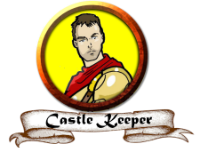Peter, thanks for the really useful comments. You are absolutely right that the APIs and the Character Sheets represent two different ways of playing. My group were not so happy with maintaining Roll20 Character Sheets as well as their paper ones, and also were focused on the Roll20 game and so not striking spells & MI charges from their paper sheets, or deducting ammo etc, so were very supportive of the approach my APIs give. But this of course does not make using the Character Sheet perfectly sensible for others as a way to play. Some will like one way and others the other way, perhaps. It is possible to combine the two ways, e.g. using MagicMaster to load weapons, but using the Character Sheet to attack with them. I agree with what you say about the videos. I wanted to get some out there quickly, as the APIs were already released via One-Click and I knew users would struggle or be daunted by the documentation without help. So videos of how they are used seemed the best way. Once I have videos covering all the functionality (at least at a high level), I'll go back and edit or rerecord them. In answer to your points: Is there any source that states that differentiating multiple attacks are always done on the even round? No. This is pure convenience for the API, but it also has the advantage of meaning that, if you don't strike with a weapon in a round then you don't drop back to a single attack the next round you attack. We used to play the way you describe, but we felt the odd/even way was fairer. However, it would be possible to add a DM flag to do it the other way and choose which to do, if people wanted. Have your considered support for pushing multiple attacks from a single source into different attack sequences / subrounds? That is indeed what the PHB says (on page 95 in my 2E PHB (c) 1989) but I think as I read it this refers to Standard initiative - the default in AD&D, where one group "wins" initiative over the other. If the system is put into Standard Initiative mode (using the Initiative menu) and the party and the foes each roll one d10 and one group wins, the multiple attacks work just as you describe - the "winning" group have first attacks, the losing group go next, and then the first group second attacks happen, etc. With "Individual" initiative (described on the same page of the PHB), it can be read that it also works this way (though I suspect that is more to do with the Haste spell mentioned in the description, than weapons that have 2 attacks per round, or 3/2 or whatever), but as a group we feel it is more realistic if it works the way it is programmed here: everyone just gets the priority that results from adding the action speed to their individual d10 roll, multiple times if that's appropriate. Since no-one "wins", you can't say who goes first or who goes second etc. Everyone (party members individually, and foes individually) go at their calculated priority. Choosing a fast weapon, such as a dagger, has real advantages and slow weapons, such as Longbows and 2-handed swords, get slow outcomes. Of course, it works equally for both sides. As the system does all the dice rolling and calculations, it also works quite fast & does not hold things up (too much...). We (as a AD&D playing group, not just me) believe this is as it should be - it feels more realistic than artificially saying "Even though I'm attacking with a dagger, 2 attacks per round, speed 2 and I rolled a 1, so I should go on 3 & 5, and you are using a 2-handed sword, 1 attack per round, speed 10 and rolled a 5, so go on 15, I'll do my first attack and then just wait around for your slow 2-handed weapon to hit me, before my fast dagger gets its second strike..." However, I can see how you read the rules as you state even for Individual and Group initiative. A future enhancement might be to have an option flag for this. Any thoughts on allowing players to change weapons "instantly" by dropping they current weapon on the ground? Absolutely - the system supports this out of the box. It's only an issue if doing Individual or Group initiative (which use action speeds) and therefore need the speed of the newly selected weapon which they won't get without first taking it in-hand. In this case, the Player would use the Attk Menu/Change Weapon command while doing initiative (to get the new weapon in-hand) before doing initiative for the next round as an attack with that weapon (so that the correct weapon speed is used) stating to the DM at the same time that they were doing this by dropping their previous weapon. If you want to be really pedantic, you could instead ask them to use the MI-Menu/Store MI option to actually place the old weapon on the ground (that's a bit OTT even for me... there would have to be a container token representing the ground that they could store it to). They would then have to remember to pick it up (use MI-Menu/Search for MIs & Treasure on the ground token) to retrieve it before they leave... The key point here is that the system does not impose any sequence to the use of commands - you can do anything at any point. The System will not stop it, but the DM might! While Change Weapon in theory takes a round, if your character is neatly sheathing their previous weapon and drawing the next, it does not have to. The system would allow you to Change Weapon, cast a spell and attack with the selected weapon all in one round - that might even be appropriate: e.g. for Mordenkainen's Sword spell, it does precisely this. It is the DM that points out that you did not have a hand free to undertake the Somatic component of the spell, so you have to drop something first... I hope all that sounds sensible, but very happy to get comments and suggestions, or even other interpretations of the rules - it might make me think of option switches I can allow DMs/players to set.




